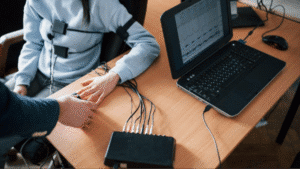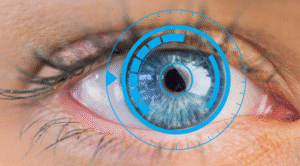Over the last decades, polygraphs have become a central theme in several films and television shows. These tests are supposedly incorporated to enrich cinematic plots and portray the technique’s efficiency.
“The Informant!,” “Meet the Parents,” and “Catch Me If You Can” are just some of the numerous blockbuster films with polygraph scenes.
But while movies have done a commendable job at popularizing lie detector tests, they seldom portray the technique accurately.
This post outlines the various ways films and television shows often misrepresent polygraph exams.
1. Polygraphs Detect Lies
Polygraphs are alternatively called ‘lie detector tests.’ However, that expression may well be a misnomer.
A lie detector test doesn’t detect lying in the literal sense of the word. Instead, it measures physiological changes synonymous with deception.
According to research, lying stimulates the autonomic nervous system (ANS). It notably causes a spike in four ANS-controlled functions – heart rate, breathing, blood pressure, and skin conductivity.
Unfortunately, many movies portray the polygraph as a direct lie detection tool.
2. Polygraphs Take A Few Minutes
In most movies, lie detector test scenes barely last ten minutes. This erroneously portrays the procedure as short and quick.
In reality, a professionally administered polygraph can last from 1 ½ – 2 ½ hours.
The actual duration will largely depend on the type of test involved (single-issue versus multiple-issue) and the extent of investigation required.

3. Polygraphs Only Involve In-test Questioning
A polygraph test doesn’t start and end with the in-test questioning. Rather, the procedure unfolds in three critical steps, which all happen on the same day;
a) Pre-test Phase
During pre-test, a polygraph examiner and examinee go over the test questions. This phase also involves collecting and examining an examinee’s physiological baseline data and reconfirming their consent.
Besides, an examiner will remind the subject to remain truthful and avoid deploying any countermeasures.
Most polygraph scenes in movies lack the pre-test phase.
b) In-test Phase
The in-test phase is where much of the polygraph questioning happens.
An examiner will ask the prerecorded questions to an examinee, with various polygraph sensors recording physiological data from each reply.
While most movies typically focus on the in-test questioning, the scenes seldom last a few minutes. That’s in contrast to real-life lie detector tests, where this stage may last from 30 minutes to 1 hour.
c) Post-test Phase
The post-test polygraph phase is all about data analysis.
After the in-test questioning, an examiner analyzes each physiological response against the baseline data recorded during the pre-test. They then assign a numerical score denoting the probability of deception.
Many movies don’t delve into the rigor of post-test polygraph data analysis. Usually, the focus is to return a quick verdict of guilt or innocence for entertainment purposes.
4. Test Questions Are Random
Some movies portray polygraph examiners crafting lie detector questions on the go. Well, the reality is a lot different.
As hinted, an examiner must prepare questions ahead of the actual in-test phase. Besides, polygraphs follow a strict question design rule. Each in-test query must be closed-ended, eliciting a simple “yes” or “no” reply. There’s no room for narrative answers.
Lie detector questions fall into different categories too, including;
- Relevant Questions – Inquire about the subject matter directly
- Control Questions – Delve into a past offense that’s somewhat relevant to the current investigation
- Irrelevant Questions – Designed to calm down an examinee during in-test questioning
- Concealed Information Questions – Gauge a subject’s knowledge of specific crime-relevant facts

5. Polygraphs Can Be Conducted Before Live Audiences
The recent past has seen numerous celebrities undergo lie detector tests on live television. Unfortunately, it’s nearly impossible to conduct a credible polygraph test before prying eyes.
A live audience can distract an examinee or make them anxious, compromising the quality of the collected data. Industry standards require polygraph tests to be taken in comfortable indoor environments.
6. Polygraphs Are Always Conducted In Police Interrogation Rooms
Many polygraph-themed movies often portray the procedure as conducted in dimly lit, poorly ventilated police interrogation rooms. The setting choice is understandable, since lie detector tests are predominantly used in criminal detective work.
However, polygraphs aren’t unique to law enforcement. The technique has since pervaded many other industries, including immigration screening, government contracting, and relationship counseling.
Even law enforcement polygraphs aren’t always conducted in police interrogation rooms. Instead, a professional examiner will recommend a neutral location to avoid undue examinee stress.
7. Polygraphs Always Nail the Perpetrators
Polygraphs are not a foolproof way to discern deception.
Therefore, a cinematic character passing a lie detector test doesn’t imply they’re necessarily innocent. Neither is failing the exam always a sign of guilt.
Note that most lie detector tests have an error rate.
According to the American Polygraph Association (APA), single-issue polygraph tests might hit an accuracy score of 95%. The 5% deficit implies there will always be an error margin.
Besides, there have been instances of false positives and false negatives. These findings only underscore the polygraph’s limitations.
The good news is that it’s almost impossible to beat a lie detector test, provided it’s professionally administered following the APA’s industry guidelines.

The Bottom Line
A polygraph scene can add a twist to a crime thriller. However, most directors incorporate lie detector tests to enrich their plots.
A real polygraph test is serious business with potentially far-reaching implications.
While you can pick certain facts from polygraph scenes in movies and television shows, the fundamental idea is usually to entertain rather than inform.






